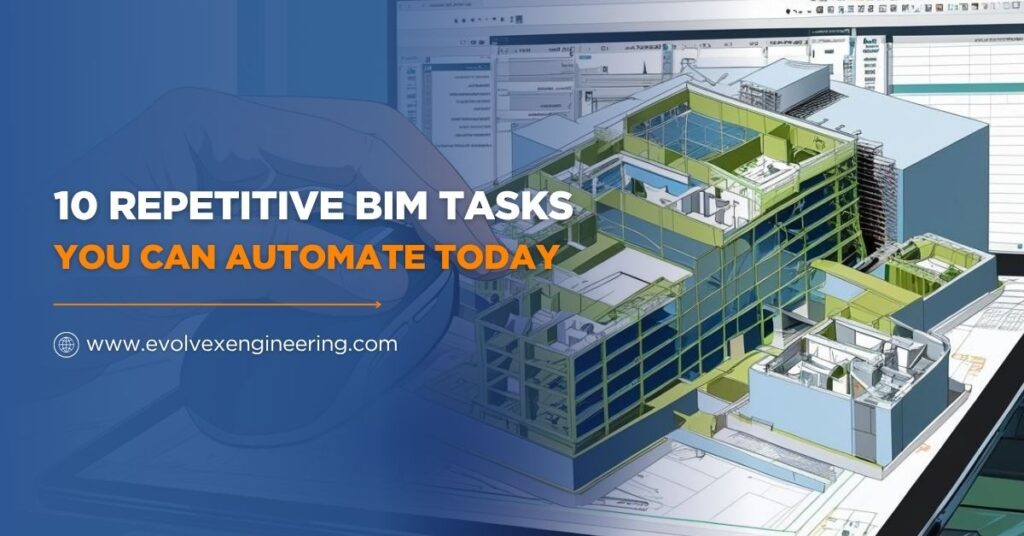Introduction
In the fast-paced world of construction and design, Building Information Modeling (BIM) has revolutionized the way professionals work. But even with this advanced technology, many repetitive BIM tasks slow down productivity.
The good news? You can automate most of these tasks today using tools like Dynamo, Revit plugins, and cloud-based platforms. Automation not only saves time but also reduces human errors and increases consistency across your BIM models.
In this blog guide, we will explore 10 Repetitive BIM Tasks that you can automate right now to improve your workflow and deliver faster, smarter projects. Whether you are a BIM Manager, Architect, MEP Engineer, or Structural Designer, this guide will help you save time and focus more on creativity and design.
Automate These 10 Repetitive BIM Tasks to Boost Productivity
1. Sheet Creation and Numbering
Why It Matters
Creating sheets manually in Revit or any BIM software is not only time-consuming but also prone to errors. You might forget to number sheets correctly or duplicate titles. This slows down the entire documentation process.
How to Automate
With tools like Dynamo or custom Revit plugins, you can automate the creation and numbering of sheets in bulk. Simply set your parameters – such as title block, discipline, and layout – and let the script do the rest.
Benefits
- Saves hours of manual work
- Reduces human errors in numbering
- Maintains consistency across project sheets
Tools to Use
- Dynamo scripts
- Revit Macros
- BIM 360 Automations
This is one of the most common repetitive BIM tasks that professionals can automate easily.
2. View Template Application
Why It Matters
View templates help maintain graphic standards across all views in a model. Applying them manually to each view is repetitive and boring.
How to Automate
You can use scripts to apply view templates to multiple views at once. Whether you are working on floor plans, sections, or elevations, automation ensures each view meets project standards.
Benefits
- Speeds up the process
- Ensures uniform visual style
- Avoids missing or inconsistent templates
This automation ensures consistent output, making it especially useful for large teams.
3. Clash Detection and Reporting
Why It Matters
Clash detection is critical in BIM coordination, especially between architectural, structural, and MEP models. But running and documenting clash reports manually takes a lot of time.
How to Automate
Use platforms like Navisworks with automated clash tests or BIM 360 with scheduled clash detection. These tools can run daily or weekly clash tests and send reports via email.
Benefits
- Speeds up coordination
- Ensures regular clash updates
- Reduces manual errors in reports
This is a high-priority repetitive BIM task that every project team should automate.
4. Model Health Checks
Why It Matters
Over time, BIM models can become messy – filled with warnings, unused views, imported CAD files, or unplaced elements. Checking model health manually can be tedious.
How to Automate
You can use Revit model checkers or cloud tools to run automatic audits. These tools inspect your model for warnings, naming conventions, and other quality control measures.
Benefits
- Keeps the model clean and efficient
- Reduces file size and improves performance
- Prevents issues before submission
Tools like Revit Model Checker and Autodesk Model Checker are excellent for automating this repetitive BIM task.
5. Parameter Standardization
Why It Matters
Different families or elements in Revit may have inconsistent parameters. Manually editing parameters across hundreds of elements is very time-consuming.
How to Automate
Use Dynamo scripts or Revit macros to standardize parameters. You can even pull data from Excel to apply uniform values across elements.
Benefits
- Saves time on manual editing
- Ensures consistency in naming and data
- Improves data export and reporting accuracy
This is a must-do for BIM teams handling large-scale models or projects involving multiple collaborators.
6. Room and Space Tagging
Why It Matters
Tagging rooms or spaces one-by-one is dull and slow, especially in large floor plans. Missing tags can delay quantity takeoffs and facility planning.
How to Automate
With Dynamo, you can place tags automatically in all rooms or spaces. Some add-ins can even detect rooms and place tags intelligently.
Benefits
- Complete tagging in seconds
- Improves accuracy for scheduling
- Eliminates missed tags
This is one of those repetitive BIM tasks that can easily be automated and offer huge time savings.
7. Renaming Views and Levels
Why It Matters
Revit often creates default names for views and levels that need to be renamed to match your naming convention. Doing this manually for dozens or hundreds of items is inefficient.
How To Automate
Use scripting tools to batch rename views based on project codes, floor levels, or types. This ensures all names are clean, understandable, and uniform.
Benefits
- Prevents naming confusion
- Helps during exporting and coordination
- Saves hours of manual updates
Again, this small but annoying repetitive BIM task is ideal for automation.
8. Exporting Views and Sheets to PDF or DWG
Why It Matters
Exporting files manually is time-intensive, especially when clients or contractors often request updates.
How to Automate
Use tools like Revit Print Organizer, Bluebeam Revu scripts, or Dynamo to export selected views and sheets with predefined settings.
Benefits
- Faster deliverables
- Avoids missing important views
- Batch export with custom names
This automation also reduces errors in document sharing.
Also Read: Top Benefits of Using BIM Automation in AEC
9. Data Extraction for Schedules and Reports
Why It Matters
Schedules are vital in BIM projects – covering doors, windows, equipment, materials, and more. Manually copying data to Excel or other formats is laborious.
How To Automate
Use built-in Revit schedules with export settings or build scripts to automate data extraction. You can also sync data with cloud tools like Power BI.
Benefits
- Real-time data reporting
- Easy integration with project dashboards
- Accurate quantity takeoff
This supports BIM automation and improves your project’s decision-making process.
10. Family Placement and Updates
Why It Matters
Placing repetitive families like light fixtures, chairs, or air diffusers across a model can take forever. If you update one family, you often have to replace it manually everywhere.
How to Automate
Use scripts to place families based on rules (like room type, ceiling height, etc.). You can also automate family updates in the entire model with version control.
Benefits
- Ensures correct placement
- Reduces human errors
- Saves time during design revisions
For large commercial or residential projects, automating this repetitive BIM task makes a significant impact.
Final Thoughts
BIM is powerful – but it becomes even smarter when you automate the tasks that don’t need manual input. These repetitive BIM tasks are not only boring, but they also take away your focus from creativity and coordination. With simple automation tools like Dynamo, Revit add-ins, and cloud platforms, you can transform your BIM workflow today.
By automating even a few of these tasks, you can:
- Deliver projects faster
- Improve model quality
- Make your team more productive
Start small, experiment with one or two automation scripts, and scale up gradually. Automation in BIM is not the future – it is the present. Embrace it and stay ahead in your game.







